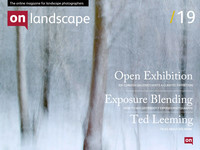Richard Childs on rust, moss and collapsing buildings

Richard Childs
Richard trained as an Orchestral Percussionist in the 1980's but his true love has always been the outdoors and particularly mountain environments. Throwing in his drumsticks to become a full-time photographer in 2004 he continues to work with a large format camera alongside digital equipment and exhibits his work in solo and group exhibitions as well as at his own gallery in the Ironbridge Gorge. Links to Website and Facebook
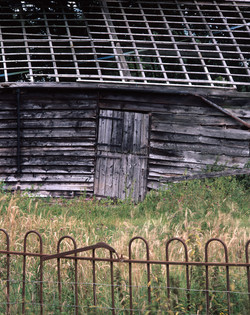 Those of you who have been out with me and my camera or who have attended one of my workshops or tours will know that I am drawn to old buildings and vehicles. On days where the weather or the light conspire to make working wider landscapes difficult I like nothing better than to go and dig out something rusting and flaky, mossy and collapsing in.
Those of you who have been out with me and my camera or who have attended one of my workshops or tours will know that I am drawn to old buildings and vehicles. On days where the weather or the light conspire to make working wider landscapes difficult I like nothing better than to go and dig out something rusting and flaky, mossy and collapsing in.
As with all my image making I regularly find myself asking the question 'why am I taking this?' or perhaps more crucially 'what is this for?'. The first question is easy to answer; because it attracts me. The poignancy of the subject matter, abandoned, left alone to be re-absorbed into its surroundings. The character of the thing, often given a sense of personality by the arrangement of tired windows, rusty fenders or leaning walls. The fantastic colours and shapes created by ageing fascinates me. The second question has however proven more difficult to answer. While I have had some success selling such images as prints and cards that's really not all that I want to achieve with my photographs, I have always hoped that in the long run they may prove to have been more useful than that.
In recent weeks I have travelled and photographed across Britain. For the most part the light has been good for details ( either harsh daylight when I head for shady nooks or raining but too windy for woodland work), especially man made ones so that is what I been hunting for.  Last week, while talking to a farmer in his Worcestershire farmyard it dawned on me how important this photography of old stuff actually is.
Last week, while talking to a farmer in his Worcestershire farmyard it dawned on me how important this photography of old stuff actually is.
I had driven past the farm a couple of times during the week and admired the tall Oast Houses at the rear but on my third passing I caught sight of what looked like old wooden shutters on the red brick barns behind the main house and vowed to call by on my return. Later, having knocked and been given permission to photograph by the farmer I was approached by his son who had just parked his tractor in front of barn doors that could have made a further image. Starting up a conversation by asking if I would photograph his wedding later in the year ( my stock answer is always 'yes, if you don't mind all my images being taken with a long lens from the top of the nearest hill') he went on to say that I was lucky to get the shots of the windows as the buildings were soon to be developed and converted into apartments, a fate to which the oast houses had already fallen. Driving back I realised how often this had happened in just one month. The chicken wire windowed byre in Taynuilt was soon to be pulled down and replaced with a mechanic's workshop; the tumbledown cottage in Appin was coming down to be replaced with a bland, pebble dash holiday home; the roofless barn in Little Hereford had only just lost its tiles, sold by the farmer for a quick buck.
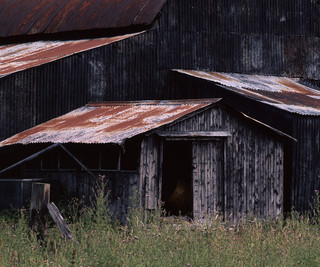 Looking back this has been going on all along, some buildings I identified for future visits were raised to the ground before I got back with my camera while others were renovated, old cars removed, flaky paint cleaned up and broken windows replaced. So now if I see something I photograph it at the earliest opportunity because at some point it will go forever and there will be no record of it as I found it, with all its character, colour and evidence of the lives who occupied it on show. I hope that you too can see the importance of documenting these old things which can be found absolutely everywhere we go but are seldom given a second glance by most people before they vanish.
Looking back this has been going on all along, some buildings I identified for future visits were raised to the ground before I got back with my camera while others were renovated, old cars removed, flaky paint cleaned up and broken windows replaced. So now if I see something I photograph it at the earliest opportunity because at some point it will go forever and there will be no record of it as I found it, with all its character, colour and evidence of the lives who occupied it on show. I hope that you too can see the importance of documenting these old things which can be found absolutely everywhere we go but are seldom given a second glance by most people before they vanish.
This brings me onto another subject matter that I believe we should all photograph as we discover it. After all it is everywhere we go, no matter how beautiful the location. Under hedges, beside stone walls, at the back of beaches,choking ditches, we are rarely more than a few feet from litter and industrial waste.
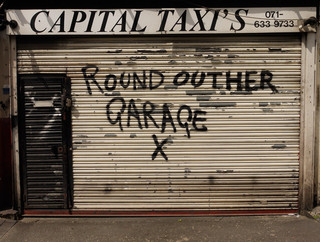 As landscape photographers we tend to strive to make images of a countryside in pristine condition. Avoiding the signs of man where we can, especially where it's ugly or shocking. Our customers understandably want to spend their hard earned cash on scenes of beauty, something to take them away from the reality of their daily lives. I wonder however how many people actually see the sheer amount of waste dumped and abandoned on our wonderful landscape as I do. Many of my customers praise my ability to reveal texture and colour in nature that they have not previously seen. My 'gift' of seeing such detail also reveals the enormous amount of damage being inflicted on nature by our activity. Maybe, just maybe by taking photographs of the less attractive elements in the landscape we may be able to draw enough peoples attention to the problem to make a change, because until they see it in print (like the beauty) I don't think they will know it's there.
As landscape photographers we tend to strive to make images of a countryside in pristine condition. Avoiding the signs of man where we can, especially where it's ugly or shocking. Our customers understandably want to spend their hard earned cash on scenes of beauty, something to take them away from the reality of their daily lives. I wonder however how many people actually see the sheer amount of waste dumped and abandoned on our wonderful landscape as I do. Many of my customers praise my ability to reveal texture and colour in nature that they have not previously seen. My 'gift' of seeing such detail also reveals the enormous amount of damage being inflicted on nature by our activity. Maybe, just maybe by taking photographs of the less attractive elements in the landscape we may be able to draw enough peoples attention to the problem to make a change, because until they see it in print (like the beauty) I don't think they will know it's there.
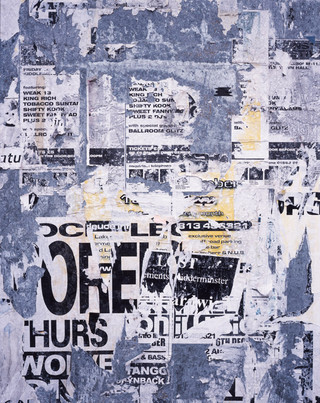 As an artistic endeavour this may not be commercially viable (or particularly original-see Fay Godwin, Edward Burtynsky etc for inspiration) but if you're there with a camera why not take a carefully composed shot or two and start to build up a collection of images that could help to encourage people and especially businesses to change their ways. I have discovered many disturbing sights on beaches over the years, gulls strangled by fishing rope; an Otter skeleton in a creel, unable to escape and drowned as the tide came in; scenes I would now photograph along with stacks of rusty leaking cans of chemicals, old tyres, dead whales and washed up Russian packing crates. Maybe over a period of time and with exposure ( I'm sure an exhibition of this subject matter would go down a storm in London) our images may have enough impact to reduce some of the unnecessary and thoughtless negative impact we are having out there.
As an artistic endeavour this may not be commercially viable (or particularly original-see Fay Godwin, Edward Burtynsky etc for inspiration) but if you're there with a camera why not take a carefully composed shot or two and start to build up a collection of images that could help to encourage people and especially businesses to change their ways. I have discovered many disturbing sights on beaches over the years, gulls strangled by fishing rope; an Otter skeleton in a creel, unable to escape and drowned as the tide came in; scenes I would now photograph along with stacks of rusty leaking cans of chemicals, old tyres, dead whales and washed up Russian packing crates. Maybe over a period of time and with exposure ( I'm sure an exhibition of this subject matter would go down a storm in London) our images may have enough impact to reduce some of the unnecessary and thoughtless negative impact we are having out there.
I would be interested in hearing from any other photographers who would perhaps like to make a more organised project out of this, the more the better. After all, the problem is to be found at all of our favourite locations, we just need to stop ignoring it.

